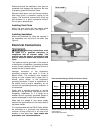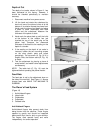
16
Planing to Desired Thickness
Thickness planing is the sizing of material to a
desired thickness, while creating a smooth
surface parallel to the opposite side of the
board. See Figure 22.
The art of thickness planing consists mainly of
using good judgment about the depth of cut in
various situations. You must take into account
not only the width of the stock, but the hardness
of the board, its dampness, straightness, grain
direction, and grain structure.
The effects of these factors upon the quality of
the finished work can only be learned through
experience. It is always advisable, whenever
working with a new type board, or one with
unusual problems, to make test cuts on scrap
material if possible prior to working on your
finished product.
Depth of Cut
The thickness of stock run through the planer is
controlled by the distance you adjust the bed
from the cutting knife. Always start your work by
making a light planing cut. The depth of cut on
subsequent passes may be increased, up to
1/8”, however, remember that a light cut creates
a finer finish than a heavier cut. See Figure 23.
Never plane more than 1/8”
in one pass and never attempt to plane a
board under 8” in length.
Thickness Planing Steps
To properly use your planer/molder for thickness
planing, follow these steps:
1. Measure the thickest part of the board to be
planed. Turn the elevation control handle
until the scale depth of cut reads the
thickness of the board to be planed. Each
revolution of the handle raises the bed 1/16”
(1.5mm)
2. If desired thickness is greater than 3/16”,
make several passes.
NOTE: It is recommended that a board be
planed on both sides to the desired thickness.
Then the moisture content will be uniform and
the drying process will not warp the board. For
example, if 3/16” thickness is desired, remove
3/32” from each side.
Figure 22
Figure 23


















